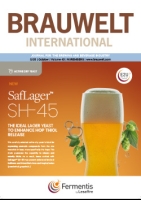Nowadays most leaf hops worldwide are processed into various hop products after harvesting. Hop products are more homogeneous, easier to handle and have better storage stability than leaf hops. In addition, brewers’ modern day requirements have become more complex, as a result of which there is a huge range of hop products with varying compositions.
Different bottle types had been tested on their permeation characteristics (including oxygen ingress and carbonation retention) and the microbiological stability of the bottled beer. The microbiological stability was assessed by measuring the turbidity and the concentration of colony forming units (CFU). Measurement of the CO2 content and the turbidity was done in beer; evaluation of the oxygen ingress had to be done in especially prepared distilled water since beer itself is oxygen-consuming. In case of microbiological growth the colonies were checked with macroscopic and microscopic methods for exclusion of unwanted microorganisms leading to an erroneous positive result.
The determination of NDMA in beer by the method of GC-TEA or GC-MS was collaboratively tested by the EBC Analysis Committee according to ISO standard 5725-2: 1994. Repeatability (r95) and reproducibility (R95) values are presented. There is statistically significant evidence (Spearman rho = 0.83, p = 0.008) of dependence of repeatability on the mean value (repeatability is worse for bigger mean), there is also statistically significant evidence (Spearman rho = 0.94, p = 0.001) of dependence of reproducibility on the mean value (reproducibility is worse for bigger mean). This relationship between s and m can be represented by a straight line s = a + bm. Final repeatability standard deviation = sr = 0.022 + 0.034 m. Final reproducibility standard deviation = sr = 0.054 + 0.117 m.5 µ/l..
In the environment, there is actually no surface without the potential for adhesion of biofilms. Especially in membrane processes, biofilms have a negative effect on the performance, resulting in higher energy costs, higher efforts for cleaning and a lower durability of membranes. Within a research project, the possibilities of a process water production from
One of the most widely known and studied medicinal properties of hops is its ability to induce sleep. In the European HMPC (Herbal Medicinal Product Committee) Monographs hops are officially recommended as traditional herbal medicinal product for relief of mild symptoms of mental stress and to aid sleep.
The seventh European Beer Star (EBS) held in 2010 was a great success: An expert panel consisting of 88 jury members from 21 countries assessed 955 beers from more than 34 countries and awarded gold, silver and bronze medals in 44 different categories – from German-style Kellerbier, Bohemian-style pilsner and various Hefeweizen specialties to English ale, stout and herb and spice beer. Apparently, there had never been so many participating breweries and so many different breweries from different countries that made it into the winner lists.
In order to better inform our customers and our research, Hopsteiner has created a most detailed picture of hop cone development in conjunction with botanical experts at New York Botanical Gardens. The new botanical standard provides great detail on morphology of hop cones and can be used by growers, scientists and technical brewers alike to compare studies of flavor change over hop cone maturation in the field.
In order to produce beers with a unique character that can easily be distinguished from other brands, brewers worldwide focus more and more on new and special aroma varieties. In 2010 the new American variety “Delta” was commercially grown for the first time and the brewers’ feedback has been promising.
The pasteurization of beer and in particular the flash pasteurization is a widely used technique for the biological product stabilization. In spite of the large extend of experience with the pasteurization the way how it is used in practice is a comparably rough method of low precision. In order to precisely adjust the two core process parameters temperature and exposition time detailed knowledge about the individual microbiological inactivation kinetics as well as about specific process and equipment characteristics is required. The article first considers the questions of the biologically demanded thermal load in terms of “required Pasteurization Units (PU)”. The assumed underlying thermal death kinetics and the determination of the necessary logarithmic cell count reduction are discussed. Every claim demanding for a particular target PU for specific kinds of beers (or other beverages) base naturally upon simplifications and assumptions concerning the initial and target cell counts and the D-values of present microorganism. The necessity of both species/strain and matrix specific D-values are pointed out.
Malt is an important industrial product with a huge market outlet. The diverse microbial communities naturally colonizing barley grains greatly influence malt quality and subsequently other products in the malt value chain, in particular beer. In this manuscript, an overview is given of current knowledge of barley and malt-derived microorganisms and their impact on malt properties. In addition, emphasis is put on strategies to enhance the malting process, including the use of starter cultures and the management of endogenous microflora. Molecular studies on microbial community composition and function throughout the process will contribute to efficient implementation of these strategies, ultimately leading to more efficient wort production and enhanced beer flavour quality and stability..
The coherence of particle size distribution and reaction behaviour is well-known in process engineering as well as in the brewing industry [15, 17, 21]. Additionally, the particle size distribution can give precious information about the status quo of several processes. Usually, in the brewhouse, only the particle size distribution of the malt grist is measured by sieving [4]. But, the particle size distribution changes during the mashing process. To measure these changes, wet sieving methods are possible but too complex to get fast and authentic results. Thus a fast and reproducible method is missing for mash. Therefore, an analysis method with laser diffraction was developed, which give brewers now the possibility to analyse the status of the mashing process..


